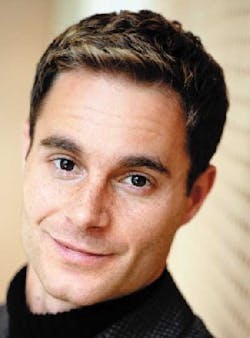Esthetics
What has started more romances, made more friendships, been preserved in portraits through the centuries, brought fame and fortune to some, and is often called the universal language of friendliness? Need a hint? How about this: "Say cheese!" Of course, it's a smile. What is more lovely on the human face than a smile? Thanks in part to the desire of baby boomers to remain young and the advances of dental material technology, smile esthetics is quickly becoming one of the biggest areas of specialization in dentistry.
"The dental profession's traditional role centered around the eradication of disease," said Dr. Jeff Morley of San Francisco, Calif., in the August 2000 issue of JADA. "It now finds itself on the threshold of uncharted territory - the enhancement of appearance."
Smiles have been studied, photographed, measured, and dismembered as plaster models for many years. There are mathematical formulas to measure what a perfect smile is and proportion rules that can be used to compare length of the face and anterior teeth. Some look for parallelism and symmetry, where horizontal planes that run parallel to each other can be drawn on the face - pupils of the eye, lips, teeth, gingival margins. But who decides what a pretty smile is? Is it a mathematics exercise or a more subjective decision? Are some smiles too wide? (Think of Julia Roberts) Too big? (Think of Mick Jagger) Are some smiles too small or "gummy"? What exactly is an esthetically pleasing smile?
"The easy dental hygiene answer is a healthy smile, according to all our traditional standards and theories of practice," says Kristine Hodsdon, RDH, and esthetic dental hygiene specialist. "The first thing we must remember is that an esthetically pleasing smile is whatever the client believes is attractive. There are objective clinical evaluations to the dental smile complex; however, the subjective opinions of our clients must be taken as their reality."
Hodsdon recommends listening very carefully to our patients, while acting as a facilitator to discover what the clients really value. "People desire things that will change their lives. Many people do not walk into our practices asking for crowns or veneers. Our clients do not want the restorative hardware or end product that our services provide. They want the finest services that will bring value and relevance to their lives. Once we determine what our clients want, then we can provide the tools (whitening, crowns, periodontal therapy, etc.) necessary to accomplish their goals."
What drives esthetics - the patient's desire for a better-looking smile or the availability of new technology that improves dental materials? "I believe that boomers have been raised to want the best," says Dr. Tim Barber of Corry, Pa., a general practitioner who has an emphasis on esthetic dentistry. "They want to look good, stay young, and they want their investment to last. Vanity may be a primary motivator, but we do have great dental materials that can help us achieve the look the patient desires."
Dr. Jeff Cummings, of Waltham, Mass., who operates a restorative and prosthodontic practice focusing on esthetics, says we often can be too quick to dismiss a patient who is concerned about his smile by saying, " 'Oh, it's fine. There's no problem.' But if the patient shows the courage to mention it, we should be quick to ask what he dislikes or what he'd like to change."
"I believe that we live in a look-good/feel-good society," says Hodsdon. She lists four main motivating factors: appearance (how things look), form (how things feel), function (how things work), and peace of mind (teeth/gums are healthy/stable).
As we age and the smile changes, there is more loss of vertical dimension, attrition, abrasion, wear facets, etc. Can these changes be reversed? The cosmetic experts respond with an emphatic "yes!" Aging baby boomers already are asking for these services. Dr. George Kirtley, of Indianapolis, writes in October 1999 Contemporary Esthetics that when the incisal edges of the centrals, laterals, and tips of the cuspids appear to be convex instead of concave - when compared to the lower lip line - it results in a more youthful smile.
"A dental hygienist is one of the best people to get the ball rolling," says Dr. Paul Homoly, a consultant and lecturer on practice management. "She has every opportunity and right to open conversations with patients and offer hope in response to their esthetic concerns." Dr. Homoly says first, however, the dentist and hygienist need to be on the same page when it comes to suggesting cosmetic procedures. "A hygienist needs to be up to speed on what's possible with cosmetic enhancements, and know what the dentist offers the patients in terms of esthetics. Is it just tooth whitening? Veneers? Minor orthodontics?"
Dr. Cummings offers additional steps to consider before talking with a patient about esthetic dentistry. Does the doctor perform esthetic procedures well? Is the hygienist proud of the work the doctor does? If she's not familiar with what he's doing with esthetics or not seeing his work, it will be hard, if not impossible, for her to make suggestions and recommendations to patients. Is there good communication between the dentist and hygienist? If she works to develop "eyes," she can see the smile-improvement possibilities like the doctor can.
One issue that dental professionals often disagree upon is at what part of the treatment phase cosmetic procedures should be performed. If a patient comes in with 4 mm pockets, plaque, and calculus and asks for a bleaching kit, what do you say? Is bleaching dangled as a carrot, only to be given out after the patient jumps through the normal perio scaling, root planing, and debridement hoops? Or do you bleach first, hoping that as tooth appearance improves, the patient will be more interested in following perio treatment and home-care regimens?
Dr. Barber says he counsels patients by telling them they have other problems that need to be addressed, but if they really want the bleach, "in this consumer-driven society, you give it to them." He also mentioned that, since bleaching contains peroxide, it may actually help. "I've actually seen patients with borderline perio use bleach and have measurements that read 2 mm afterwards. I haven't seen any studies that show bleaching hurts perio health."
"In the traditional, textbook classic hierarchy of needs," says Dr. Homoly, "first we concentrate on infection and pain elimination. Optimally, we want healthy hard and soft tissues, then we restore the occlusion. But this is not the only way to do it. We may need to remind ourselves that the only reason for our existence is for the patient. We need to make patients feel good about themselves and dentistry. Patient care begins with a feeling, not a procedure. It doesn't matter what your recommendations are if the patient is not ready or willing to have treatment. Who is better serviced - a patient with moderate perio whom you bleach and make happy, or one whom you withhold bleach from and put on the perio treatment treadmill? It's the intangibles that make people ready."
Communication icebreakers could take these forms: Dr. Barber approaches a patient asking, "Would you like to hear how you can brighten your smile?" Dr. Cummings questions, "Are you happy with the shape and color of your teeth? If not, what don't you like?"
Dr. Homoly suggests hygienists talk to patients before the cleaning even starts with a dialogue that begins like this: "You know, we have you scheduled for a routine, periodic cleaning. I'm wondering if now is a good time to discuss your overall appearance and what's best for you." He adds, "If it's not a good time, the patient will say so, but the seed has been planted for the future. If the patient is interested, it's easy for the hygienist to get the dentist involved in the conversation. It then becomes an easy transition for the hygienist to take the necessary photographs, models, charting, and do a cosmetic analysis."
Some hygienists shy away from talking about cosmetic dentistry because of the fees. But Dr. Roger Levin wrote, in the Spring 2000 Journal of Cosmetic Dentistry, "Esthetic dental patients do not need esthetic dental services. Their decisions are predicated on value and desire." He continues to say case acceptance isn't about affording the care, but about the patient having the desire to have the treatment done.
Hodsdon said, "As long as we take the time to discover the values that are important to our clients and match them with the finest services our practices have to offer, we will have the opportunity to meet and exceed their esthetic smile expectations - no matter what their age."
Cathleen Terhune Alty, RDH, is a frequent contributor to RDH. She is based in Clarkston, Mich.

